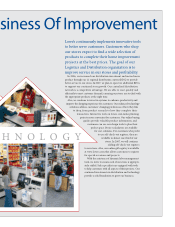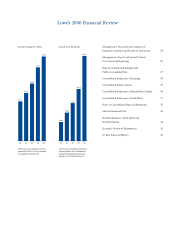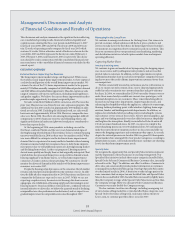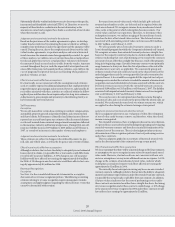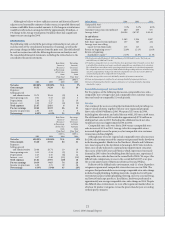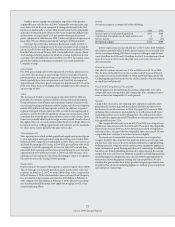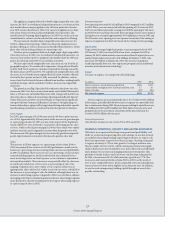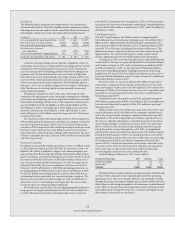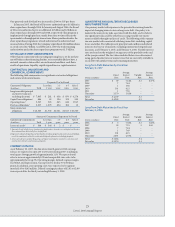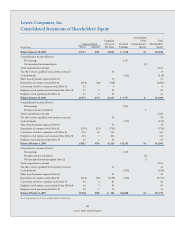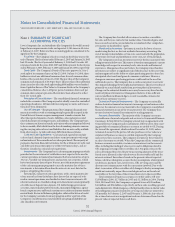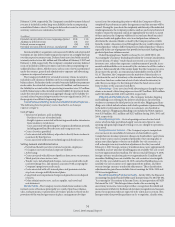Lowe's 2006 Annual Report Download - page 28
Download and view the complete annual report
Please find page 28 of the 2006 Lowe's annual report below. You can navigate through the pages in the report by either clicking on the pages listed below, or by using the keyword search tool below to find specific information within the annual report.
24
Lowe’s 2006 Annual Report
Cash Flows
e following table summarizes the components of the consolidated
statements of cash ows. is table should be read in conjunction with the
following discussion and analysis and the consolidated nancial statements,
including the related notes to the consolidated nancial statements:
(In millions) 2006 2005 2004
Net cash provided by operating activities $ 4,502 $ 3,842 $ 3,073
Net cash used in investing activities (3,715) (3,674) (2,362)
Net cash used in nancing activities (846) (275) (1,047)
Net decrease in cash and
cash equivalents (59) (107) (336)
Cash and cash equivalents, beginning of year 423 530 866
Cash and cash equivalents, end of year $ 364 $ 423 $ 530
Cash ows from operating activities provide a signicant source of
our liquidity. e increase in cash provided by operating activities in 2006
compared to 2005 resulted primarily from increased net earnings and
increased days payable outstanding, partially oset by the timing of tax
payments and a decline in deferred revenue associated with Specialty
Sales. e increase in cash provided by operating activities in 2005 com-
pared to 2004 resulted primarily from increased net earnings as well as
a lower investment in inventory compared to 2004. Working capital at
February 2, 2007, was $1.8 billion compared to $2.0 billion at February 3,
2006. e decrease in working capital was due primarily to increased
days payable outstanding.
e primary component of net cash used in investing activities
continues to be opening new stores, investing in existing stores through
resets and remerchandising, and investing in our distribution center and
information technology infrastructure. Cash acquisitions of xed assets
were $3.9 billion for 2006, $3.4 billion in 2005 and $2.9 billion in 2004.
e February 2, 2007, retail selling space of 157 million square feet rep-
resented a 12% increase over February 3, 2006. e February 3, 2006,
retail selling space of 140 million square feet represented a 13% increase
over January 28, 2005.
e increase in cash used in nancing activities in 2006 compared to
2005 resulted primarily from greater repurchases of common stock under
our share repurchase program. e decrease in cash used in nancing
activities in 2005 compared to 2004 resulted primarily from the proceeds
from the October 2005 issuance of $1 billion in senior notes and fewer
share repurchases, oset by greater scheduled debt repayments. e ratio
of debt to equity plus debt was 22.0% and 19.8% as of the years ended 2006
and 2005, respectively.
Sources of Liquidity
In addition to our cash ows from operations, we have a $1 billion senior
credit facility that expires in July 2009 that also provides a source of
liquidity. e facility is available to support our commercial paper pro-
gram and for direct borrowings. Borrowings made are priced based upon
market conditions at the time of funding in accordance with the terms of
the senior credit facility. e senior credit facility contains certain restric-
tive covenants, which include maintenance of a debt leverage ratio as
dened by the facility. We were in compliance with those covenants at
February 2, 2007 and February 3, 2006. Fieen banking institutions are
participating in the $1 billion senior credit facility. As of February 2, 2007,
we had $23 million outstanding under the senior credit facility, but no
outstanding borrowings under our commercial paper program. The
interest rate on the short-term borrowings was 5.4%. As of February 3,
2006, there were no outstanding borrowings under the senior credit
facility or under our commercial paper program.
Five banks have extended lines of credit aggregating $486 million for
the purpose of issuing documentary letters of credit and standby letters
of credit. ese lines do not have termination dates and are reviewed
periodically. Commitment fees ranging from .225% to .50% per annum
are paid on the letters of credit amounts outstanding. Outstanding letters
of credit totaled $346 million as of February 2, 2007, and $316 million as
of February 3, 2006.
Cash Requirements
Our 2007 capital budget is $4.6 billion, inclusive of approximately
$300 million of lease commitments, resulting in a net cash outow of $4.3
billion in 2007. Approximately 81% of this planned commitment is for
store expansion and new distribution centers. Expansion plans for 2007
consist of 150 to 160 stores, including 4 relocations of older stores. is
planned expansion is expected to increase sales oor square footage by
approximately 11%. All of the 2007 projects will be owned, which
includes approximately 32% that will be ground-leased properties.
On February 2, 2007, we owned and operated 11 regional distribution
centers (RDCs). We expect to open additional RDCs in Rockford, Illinois,
and Lebanon, Oregon, in 2007, and are planning for an additional RDC
in 2008. On February 2, 2007, we also operated 13 atbed distribution
centers for the handling of lumber, building materials and other long-
length items. We owned 12 of these atbed distribution centers, and we
leased one atbed distribution center. We expect to open two additional
atbed distribution centers in 2007.
In October 2006, we issued an additional $1 billion of unsecured
senior notes, comprised of two tranches: $550 million of 5.4% senior
notes maturing in October 2016 and $450 million of 5.8% senior notes
maturing in October 2036. Interest on the senior notes is payable semi-
annually in arrears in April and October of each year until maturity,
beginning in April 2007.
From their issuance through the end of 2006, principal amounts of
$967 million, or approximately 96% of our February 2001 convertible notes,
had converted from debt to equity. In 2006, $118 million in principal
amounts converted.
Holders of the senior convertible notes, issued in October 2001, may
convert their notes into 34.424 shares of the company’s common stock
only if: the sale price of the company’s common stock reaches specied
thresholds, or the credit rating of the notes is below a specied level, or
the notes are called for redemption, or specied corporate transactions
representing a change in control have occurred. ere is no indication
that we will not be able to maintain the minimum investment grade
rating. From their issuance through the end of 2006, an insignicant
amount of the senior convertible notes had converted from debt to equity.
During the fourth quarter of 2006, our closing share prices reached the
specied threshold such that the senior convertible notes are convertible
at the option of each holder into shares of common stock in the rst
quarter of 2007. Cash interest payments on the senior convertible notes
ceased in October 2006. We may redeem for cash all or a portion of the
notes at any time, at a price equal to the sum of the issue price plus
accrued original issue discount on the redemption date.
Our debt ratings at February 2, 2007, were as follows:
Current Debt Ratings S&P Moody’s Fitch
Commercial paper A1 P1 F1+
Senior debt A+ A1 A+
Outlook Stable Stable Stable
We believe that net cash provided by operating activities and nancing
activities will be adequate for our expansion plans and other operating
requirements over the next 12 months. However, the availability of funds
through the issuance of commercial paper and new debt could be adversely
aected due to a debt rating downgrade or a deterioration of certain nancial
ratios. ere are no provisions in any agreements that would require early
cash settlement of existing debt or leases as a result of a downgrade in our
debt rating or a decrease in our stock price.



